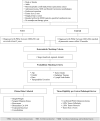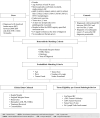NCI SEER-Linked Virtual Tissue Repository Pilot
- PMID: 39102878
- PMCID: PMC11300006
- DOI: 10.1093/jncimonographs/lgae034
NCI SEER-Linked Virtual Tissue Repository Pilot
Abstract
Background: The Surveillance, Epidemiology, and End Results (SEER) Program with the National Cancer Institute tested whether population-based cancer registries can serve as honest brokers to acquire tissue and data in the SEER-Linked Virtual Tissue Repository (VTR) Pilot.
Methods: We collected formalin-fixed, paraffin-embedded tissue and clinical data from patients with pancreatic ductal adenocarcinoma (PDAC) and breast cancer (BC) for two studies comparing cancer cases with highly unusual survival (≥5 years for PDAC and ≤30 months for BC) to pair-matched controls with usual survival (≤2 years for PDAC and ≥5 years for BC). Success was defined as the ability for registries to acquire tissue and data on cancer cases with highly unusual outcomes.
Results: Of 98 PDAC and 103 BC matched cases eligible for tissue collection, sources of attrition for tissue collection were tissue being unavailable, control paired with failed case, second control that was not requested, tumor necrosis ≥20%, and low tumor cellularity. In total, tissue meeting the study criteria was obtained for 70 (71%) PDAC and 74 (72%) BC matched cases. For patients with tissue received, clinical data completeness ranged from 59% for CA-19-9 after treatment to >95% for margin status, whether radiation therapy and chemotherapy were administered, and comorbidities.
Conclusions: The VTR Pilot demonstrated the feasibility of using SEER cancer registries as honest brokers to provide tissue and clinical data for secondary use in research. Studies using this program should oversample by 45% to 50% to obtain sufficient sample size and targeted population representation and involve subspecialty matter expert pathologists for tissue selection.
Published by Oxford University Press 2024.
Conflict of interest statement
The authors have no conflicts of interest to disclose.
Figures





References
-
- US Food and Drug Administration. 2018 Drug Trials Snapshots Summary Report. https://www.fda.gov/media/120253/download. Published January 2019. Accessed April 29, 2024.
-
- Vespa J, Medina L, Armstrong DM. Demographic Turning Points for the United States: Population Projections for 2020 to 2060. https://www.census.gov/content/dam/Census/library/publications/2020/demo.... Published March 2018. Accessed April 29, 2024.
MeSH terms
Grants and funding
- National Institutes of Healt
- HHSN261201300009I/CA/NCI NIH HHS/United States
- Public Health Institute, Cancer Registry of Greater California
- HHSN261201800007I/School of Public Health Louisiana State University Health New Orleans
- HHSN261201800016C/CA/NCI NIH HHS/United States
- University of Hawaii Cancer Center
- HHSN261201800016I/CA/NCI NIH HHS/United States
- P30 CA177558/CA/NCI NIH HHS/United States
- HHSN261201800012C/CA/NCI NIH HHS/United States
- NH/NIH HHS/United States
- HHSN261201800012I/CA/NCI NIH HHS/United States
- HHSN261201800002C/CA/NCI NIH HHS/United States
- HHSN261201800013I/CA/NCI NIH HHS/United States
- HHSN261201800009I/CA/NCI NIH HHS/United States
- HHSN261201800013C/CA/NCI NIH HHS/United States
- Surveillance Research Program, Division of Cancer Control and Population Sciences
- HHSN261201800002I/HH/HHS/United States
- PCAN/Pancreatic Cancer Action Network/United States
- HHSN261201800002B/CA/NCI NIH HHS/United States
LinkOut - more resources
Full Text Sources
Medical

